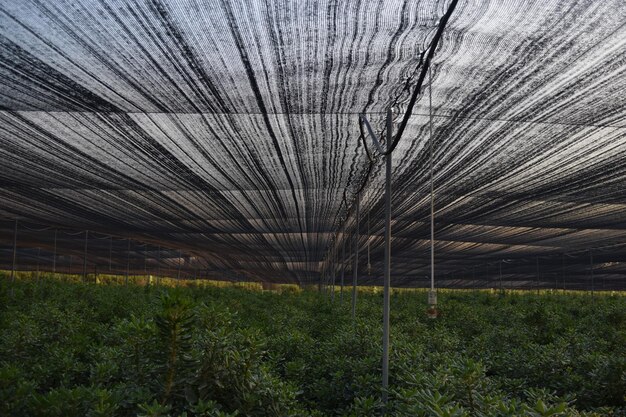As South African farmers face increasing challenges from climate change, erratic weather patterns, and water scarcity, innovative agricultural practices are becoming essential to ensure sustainable farming. One such innovation is shade net farming, a practice gaining popularity across the country due to its ability to protect crops while enhancing yields.
Shade net farming involves using specially designed nets to cover crops, creating a controlled environment that shields them from excessive heat, wind, and pests. Here’s why South African farmers should consider adopting shade net farming and how it can benefit their crops.
1. Protection from Harsh Sunlight
South Africa’s intense sun, especially in the summer months, can cause significant stress on crops. Excessive heat and direct sunlight can lead to sunburn on fruits and vegetables, reducing their market value. Shade nets filter the sunlight, allowing a specific percentage to reach the plants based on the type of crop being grown.
- Benefit: The filtered light reduces the risk of sunburn and allows for better plant growth by maintaining optimal temperatures. Crops like tomatoes, peppers, and lettuce thrive under the diffused light provided by shade nets.
2. Water Conservation
Water scarcity is a critical issue in many parts of South Africa, and farmers are constantly seeking ways to optimize water use. Shade nets reduce evaporation rates by limiting the amount of direct sunlight that hits the soil. This means that less water is required to keep crops hydrated, which is a key advantage in areas with limited water resources.
- Benefit: Shade nets help conserve water by maintaining soil moisture levels, allowing farmers to use water more efficiently and reduce irrigation costs.
3. Wind Protection
Strong winds can cause physical damage to crops, particularly young plants, by breaking stems or damaging leaves. Winds can also blow away topsoil, reducing the nutrients available to crops. Shade nets act as a barrier, reducing wind speeds and creating a more stable growing environment.
- Benefit: By protecting plants from wind damage, shade nets improve plant health and allow crops to grow without disruption, leading to better yields and higher-quality produce.
4. Reduced Pest and Disease Pressure
Pests and diseases are major threats to crop production in South Africa. Shade netting helps to create a physical barrier that prevents many pests from reaching the crops. Additionally, the controlled environment under the nets reduces the spread of diseases, particularly those caused by insects and other vectors.
- Benefit: Farmers can reduce their reliance on chemical pesticides, leading to more environmentally friendly farming practices and lowering input costs. Crops grown under shade nets are also less likely to suffer from disease-related losses.
5. Extended Growing Seasons
One of the biggest advantages of shade net farming is the ability to extend the growing season. By regulating temperature and humidity, shade nets allow farmers to grow crops outside of their typical season, giving them a competitive edge in the market.
- Benefit: Farmers can grow crops earlier or later in the season, ensuring consistent production and potentially accessing higher prices when supply is low.
6. Improved Crop Quality and Yield
Shade nets create a more consistent growing environment, which leads to healthier plants and improved yields. Fruits and vegetables grown under shade nets often have better color, size, and texture, making them more attractive to buyers.
- Benefit: Higher-quality crops mean better prices in the market, increasing profitability for farmers. In addition, the improved growing conditions result in higher yields, allowing farmers to maximize their output.
7. Types of Shade Nets and Their Uses
There are various types of shade nets available in South Africa, each with different levels of shading and benefits for specific crops.
- 30%-40% shade nets: Ideal for crops like tomatoes, peppers, and leafy vegetables, which require moderate sunlight.
- 50%-60% shade nets: Suitable for shade-loving crops like lettuce, spinach, and some flowers.
- 70%-90% shade nets: Typically used for nurseries, where young plants are grown before being transplanted.
Farmers should choose the shade net that best suits their crop’s needs and local climate conditions.
How to Implement Shade Net Farming
If you’re considering shade net farming, here are some steps to get started:
- Choose the Right Net: Consider the crop type, local climate, and the percentage of shade needed. Consulting with an agricultural specialist or supplier can help you choose the most suitable net.
- Set Up the Structure: You’ll need a sturdy frame to support the shade net. The structure should be high enough to allow air circulation and tall crops to grow. Common materials for frames include steel, wood, or PVC pipes.
- Monitor and Adjust: Once the shade net is installed, monitor the growing environment to ensure the crops are thriving. Adjust irrigation levels, pest control methods, and other farming practices as necessary.
- Maintain the Nets: Regularly inspect the nets for any tears or damage, as well as potential pest infestations. Well-maintained nets can last for many seasons.
Shade net farming offers South African farmers a practical and effective way to protect their crops from environmental stresses while boosting productivity. By investing in shade netting, farmers can achieve higher yields, conserve water, reduce pest and disease pressure, and produce better-quality crops. As climate change continues to impact agricultural practices, shade net farming is an essential tool for ensuring sustainable and profitable farming in South Africa.
Embrace the future of farming with shade nets, and watch your crops flourish under the protective cover they provide.
Join 'Farmers Mag' WhatsApp Channel
Get the latest Farming news and tips delivered straight to your WhatsApp
CLICK HERE TO JOIN






